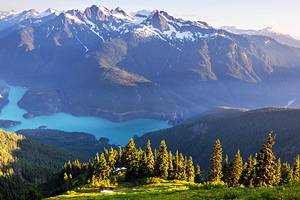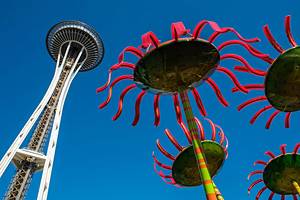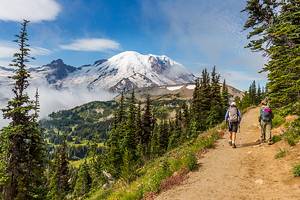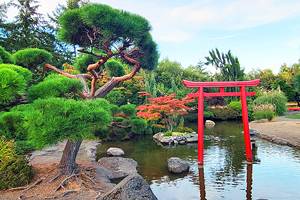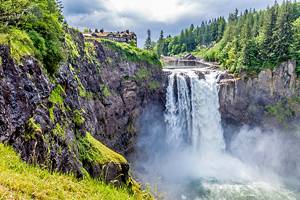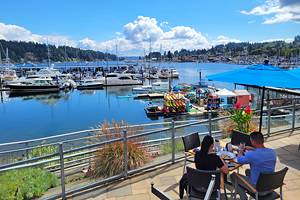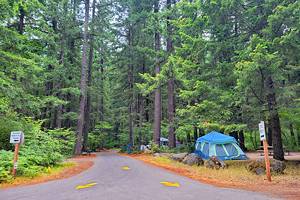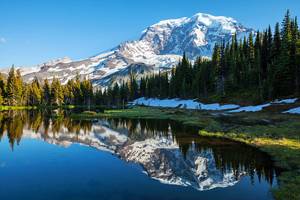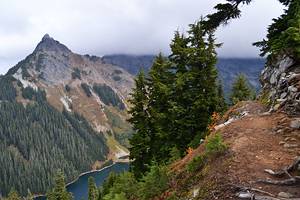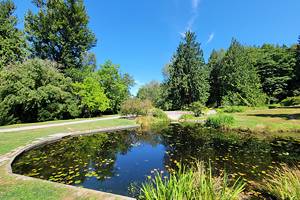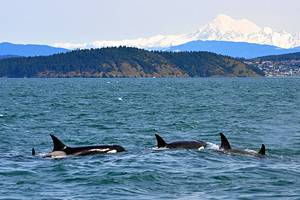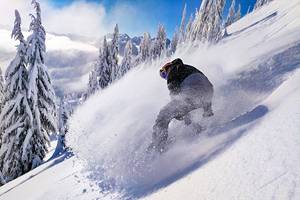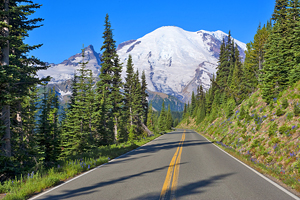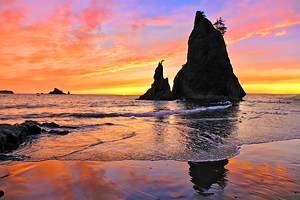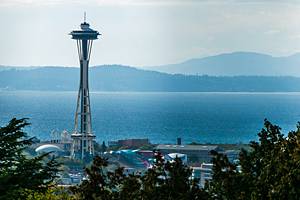Campgrounds at Mt. Rainier National Park
A sudden gasp of awe often accompanies seeing Mount Rainier up close for the first time. As the most prominent peak in the Pacific Northwest at 14,410 feet above sea level, its enormity is unmatched throughout the rest of the region. And the best way to take in the many different glaciers adorning the mountain is to spend the night at one of the many surrounding campgrounds.
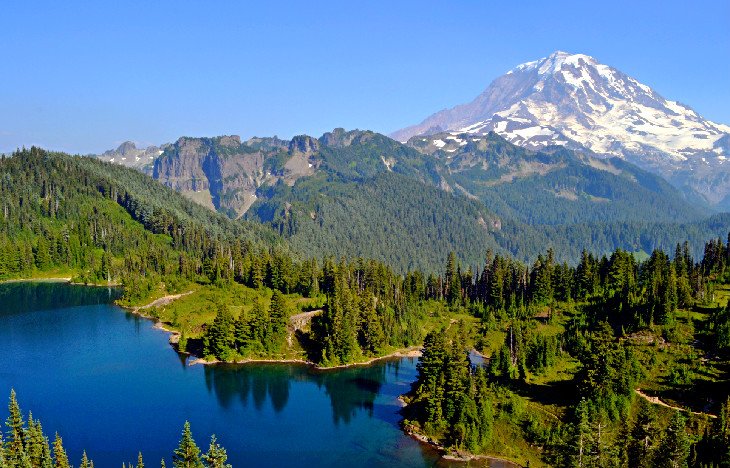
Mount Rainier National Park operates four campgrounds within its boundaries. These campgrounds, including popular ones like Cougar Rock and Ohanapecosh, lend access to aptly named areas of the park, like Paradise and Sunrise. These campsites are increasingly popular and hard to secure, making reservations the way to go when available.
Several other campgrounds lie within the Mt. Baker-Snoqualmie and Gifford-Pinchot National Forests, which surround the national park. These Forest Service campgrounds have basic amenities like picnic tables and fire rings. Many of these campgrounds are within minutes of a park entrance, and these campgrounds are popular spots on summer weekends.
Other camping options at Mount Rainier include backcountry campsites, which require a permit, and primitive camping along the side of forest service roads. Plan ahead and start your research with our list of the top campgrounds at Mt. Rainier National Park.
Cougar Rock Campground
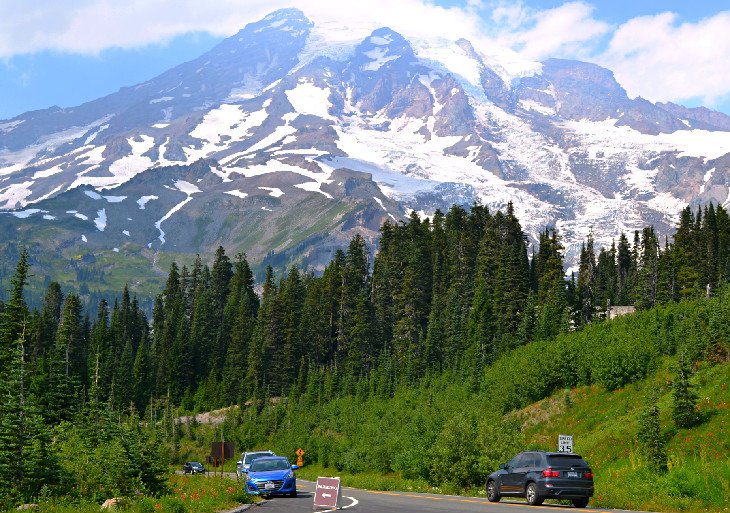
Near the Nisqually River in the southwest section of the park, expect all 173 campsites at Cougar Rock Campground to be well used throughout the season. The main reason why reservations are recommended is the campground's proximity to the popular Henry M. Jackson Visitor Center and Paradise area of the park.
Less than a 10-mile drive from the campground, campers encounter the dramatic mountain scene at Paradise, including one of Washington's best hiking trails, the Skyline Trail. This area of the park is also home to the Paradise Inn, a beautiful mountain lodge dating back to 1916.
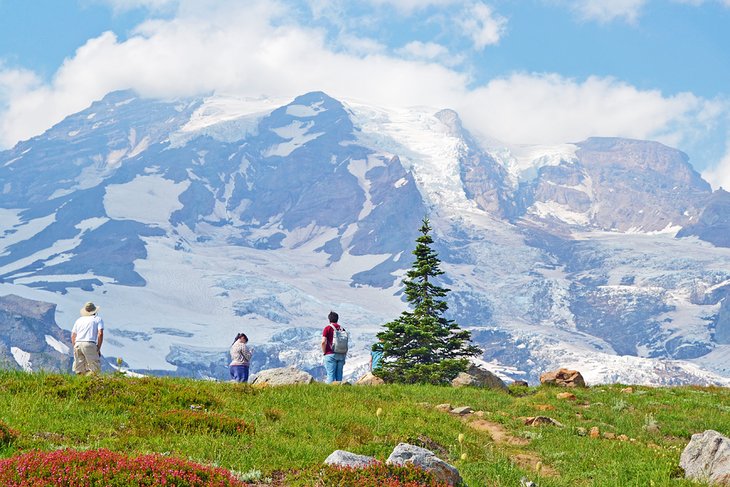
Cougar Rock provides space for tent campers and RVs (no electrical hookup), as well as potable water and flushing toilets. The popularity of this campground is also partially attributed to the spacious sites, buffered by trees and green space that add a sense of privacy. Sites are reservable between late May and early September.
Ohanapecosh Campground
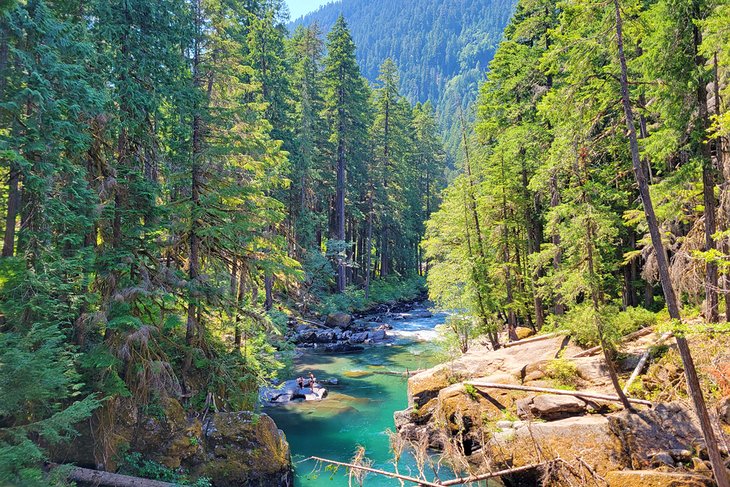
Ohanapecosh is the largest campground within Mount Rainier and is accessible via the southeast Stevens Canyon Entrance (closed in winter). This scenic location adds much to the appeal of Ohanapecosh Campground in that it's a great halfway point between two of the most popular sections of the park: Paradise and Sunrise.
Much of the Ohanapecosh appeal also comes from the old-growth forest surrounding its 188 campsites. The strikingly blue (and strikingly cold) Ohanapecosh River also carves its way next to the campground, offering a perpetual postcard to explore.

While Paradise and Sunrise are both good directions to head, many great hiking trails stem right from Ohanapecosh Campground. The Grove of the Patriarchs trail is less than a mile away, and the stunning Silver Falls trail can be accessed from the end of "Loop B."
The campground accommodates tents and RVs and has running water alongside restroom facilities and flushing toilets. Campsites can be reserved six months in advance. The large amphitheater within the campground also hosts ranger programs in the evening throughout the summer.
White River Campground
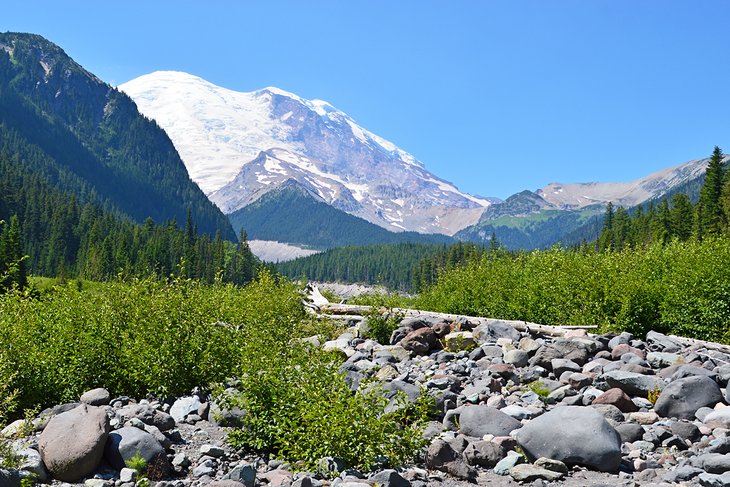
White River Campground is in the northeast section of the park at an elevation of 4,4400 feet. It's typically the first to close for the winter season and the last to open. All 112 campsites at the campground are granted on a first-come, first-served basis and cater mostly towards tent campers with no pull-through sites available. Flushing toilets and running water are available within every loop of the campground.
The campgrounds access to the surrounding environment is excellent, including the stunning and surrounding White River Valley. The Wonderland Trail wanders right through the campground, and other hiking trails, including the Glacier Basin Trail, beckon for a great day trip.
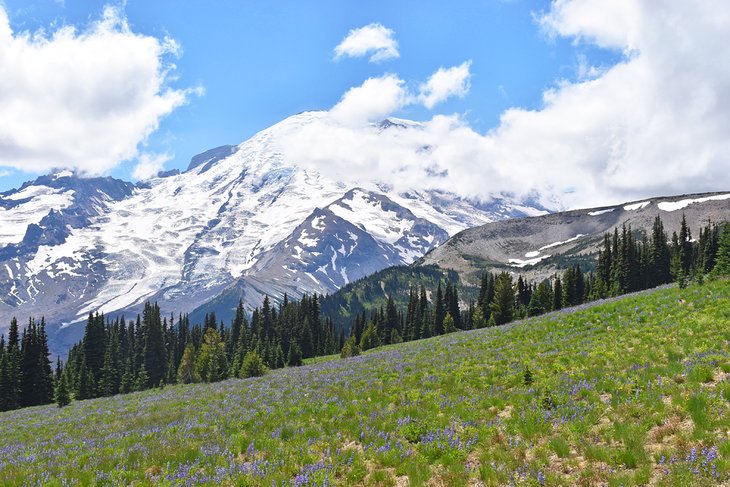
The Sunrise area of the park is accessible with a 2.5-mile hike from the White River Campground, or a scenic ten-mile drive to the Sunrise Visitors Center. Here, some of the closest views of the mountain are afforded from this high vantage point.
Mowich Lake Campground
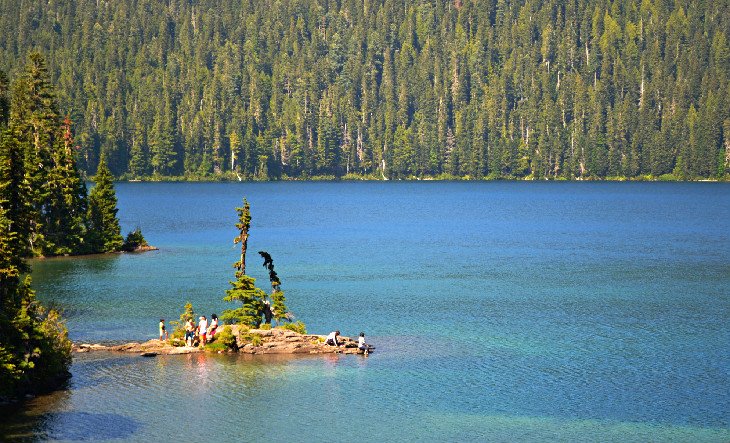
Mowich Lake Campground is in the northwest section of Mount Rainier, sometimes referred to as the "quiet corner of the park. It's a bumpy 17 miles of driving of unpaved State Route 165 to reach Mowich, but the scenery at the end of the gravel road is well worth the effort to visit.
Mowich Lake is the largest and deepest lake within the national park, and its water is warm enough to enjoy a swim during the summer season. The campground near its shore is the smallest established auto campground within Mount Rainier. It features 10 campsites available on a first-come, first-served basis.
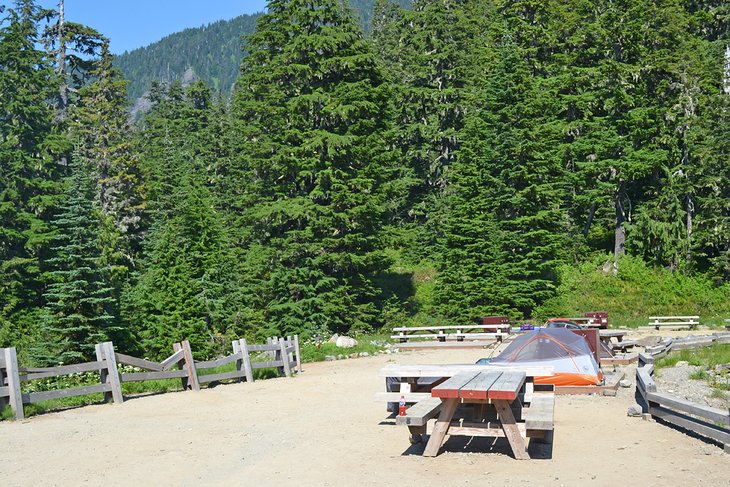
There is no fee to camp at Mowich Lake, just heavy competition to secure a spot. Parking is not available at the individual campsites, but NPS wheelbarrows are available to haul gear from the parking area nearby. The campground is also in a busy area, lending to limited privacy throughout a stay.
Recreation options abound in every direction from the campground. Nearby, the Tolmie Peak Lookout trail provides a great view of the towering Rainier in the distance. Other popular recreational outlets nearby include Spray Park and Spray Falls, as well as numerous different backcountry trailheads.
La Wis Wis Campground

La Wis Wis Campground is just outside of the southeast park boundary within the Gifford Pinchot National Forest. This Forest Service campground lends quick access to the Stevens Canyon Entrance of the park, a 15-minute drive away. And the campground, itself, is surrounded by natural attractions.
Including the Ohanapecosh River, the campground is at the confluence of three waterways. Large Douglas firs and red cedars surround these banks, where all 122 sites at La Wis Wis are scattered and shaded beneath. The campground accommodates tent campers and RVs and provides flushing toilets and potable water.
Popular recreational outlets at La Wis Wis include the Blue Hole Trail and easy access to the cascading Purcell Falls. La Wis Wis also has spacious group sites available with advanced reservations. All sites at La Wis Wis are reservable up to six months in advance.
Big Creek Campground
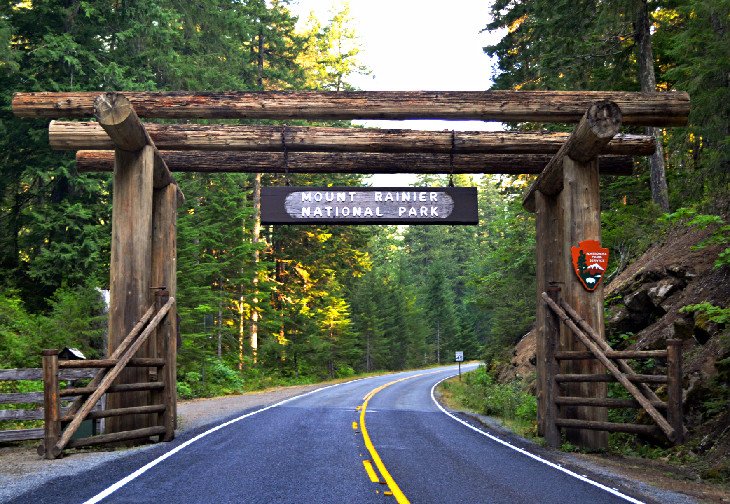
Within the Gifford Pinchot National Forest abutting the southwest section of the national park, less than six miles from the Nisqually Entrance, Big Creek Campground provides a great home base to explore the park and immediate surroundings.
Twenty-six sites and three double sites are within the single loop of Big Creek Campground, as well as vault toilets and potable water. The campground accommodates tents, trailers, and RVs up to 22 feet in length.
The well-spaced sites and mature forest provide a sense of privacy, and Big Creek is often a popular spot for family camping outings. Fishing in Skate Creek is a popular recreation option close to the campground, as are day hikes and overnight endeavors on the adjacent Sawtooth Trail system.
Silver Springs Campground
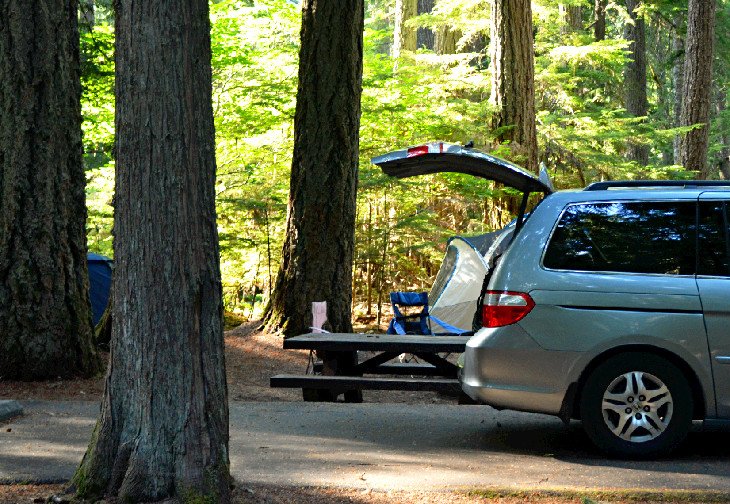
If the White River Campground is full, an equally scenic alternative can be found just twelve miles away at the Silver Springs Campground outside of park boundaries. Silver Springs is within the Mt. Baker-Snoqualmie National Forest and has 55 sites to choose from. A large group site is also available, accommodating up to 50 people.
Campsites at Silver Springs are available for advance reservation. Each site includes access to potable water and flushing toilets and can accommodate tents, trailers, and RVs.
Sunrise is the closest area of Mount Rainier to Silver Springs Campground, and other recreation options within proximity include salmon fishing in the White River and trekking on the Crystal Mountain Trail.
Hause Creek Campground
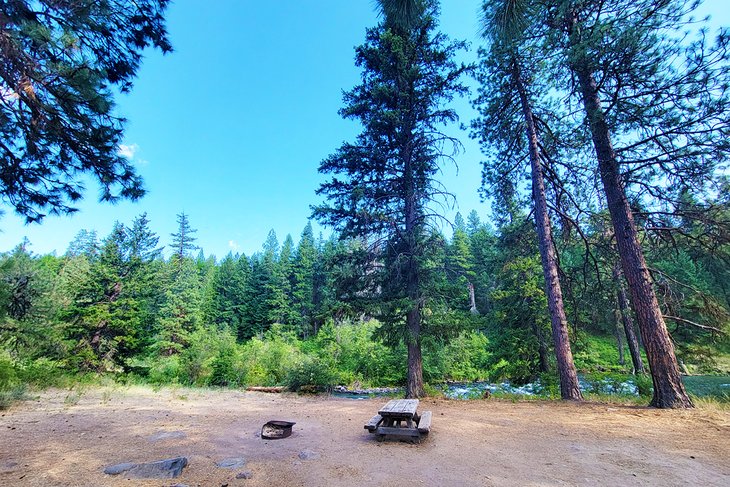
Hause Creek Campground is on Highway 12, approximately 35 miles east of the Stevens Canyon Entrance of the park. This Forest Service campground has over 40 standard sites available, accommodating tents and small recreational vehicles. Except for picnic tables and fire rings, the campground has few other amenities. Visitors need to pack in their own water.
The Tieton River flows audibly next to the campground. This beautiful waterway gives campers a way to cool off by sitting next to the shore during the heat of summer. The river also rumbles loud enough to block out any noise coming from camping neighbors. This gives each campsite a welcome sense of privacy.
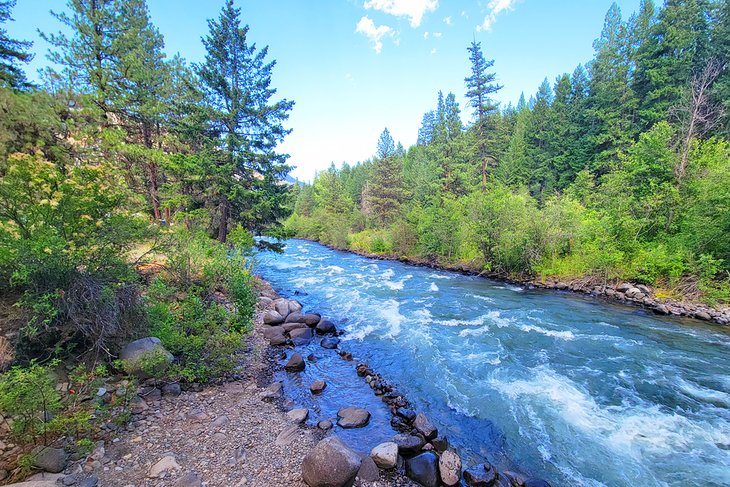
Because it's roughly a 45-minute drive to the park, the campground doesn't see crowds as big as some of the other places to pitch a tent closer by. Still, the campground does tend to book out on summer weekends. Advance reservations are available.
Buck Creek Campground

Not to be confused with the Buck Creek Campground in the Mt. Baker-Snoqualmie National Forest farther north, this Buck Creek Campground is near the White River Entrance Station and spans the semi-active Ranger Creek Airstrip.
The Buck Creek Campground is much more primitive than other camping options near the park. It's only loosely regulated, with no camp hosts and a very minimal fee to spend the night. The road into the campground is cratered with severe potholes, and every site is available on a first-come, first-served basis. It's a good campground to try for last-minute trips.
Near the beginning of the camping area, large plots cater to bigger groups of campers or large RVs that can navigate the bumpy road. Because of the lack of supervision at the campground, no one is there to enforce quiet time or other camping etiquettes. Garbage and waste disposal has been a problem in the past, prompting the Forest Service to consider closing down the site. Do your part when visiting and leave the area cleaner than you found it.
Sunrise Camp

Spending the night at one of the auto campgrounds at Mount Rainier is a memorable experience, but even more excitement can be found in the park's backcountry and wilderness trailside camps.
To spend the night in these hike-in camps, users need to obtain a permit, which can be reserved ahead of time or on a first-come, first-served basis at any ranger station within the park (subject to availability). Proper knowledge, including how to store your food, is key to enjoying unsupported time in the Rainier backcountry, and having a flexible itinerary will help ensure you get a sought-after permit.

Sunrise Camp is a great introduction to backcountry camping in Mount Rainier or a great start for a multi-day excursion. It's less than a mile hike from the Sunrise Visitor Center and features an impressive backdrop. Eight individual sites and two group sites are available at this trailside camp, and a nearby primitive toilet is shared by all overnight visitors (bring your own toilet paper).
Ipsut Creek Campground
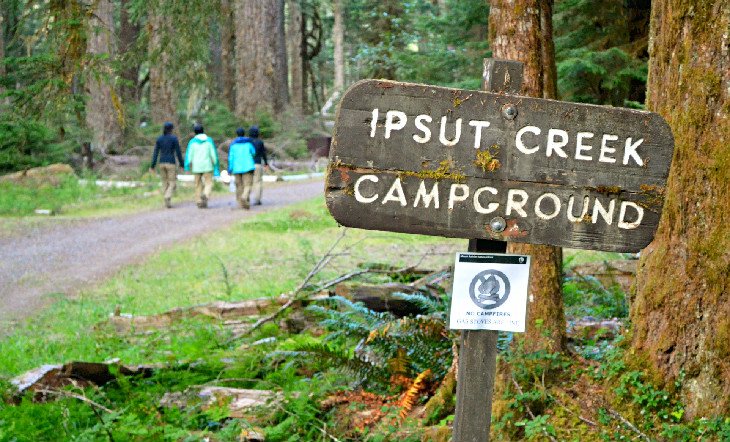
Ipsut Creek Campground is perhaps the most unique backcountry camp in the park. It was once a drive-to campground until a 2006 flood washed out the main road to the campsites, effectively leaving hiking or cycling as the only way to access the overnight space.
Today, backcountry permits are required to occupy any one of the 22 campsites available at Ipsut Creek. Permits are easier to acquire thanks to the abundance of campsites.
It's a five-mile trek or bike ride along the old Carbon River Road to arrive at the campsites, or a similar distance to hike from Mowich Lake. Most sites at the campground still have picnic tables available, and a pair of vault toilets are centrally located. Ipsut Creek is often a popular jumping-off point for multi-day backpacking trips in the northwest section of the park.
Camp Muir
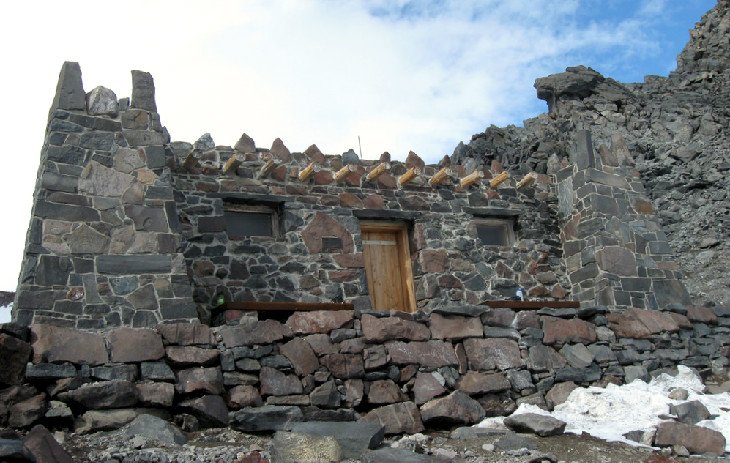
If you are climbing Mount Rainier, Muir Camp, located at an elevation of 10,000 feet, is likely one of the first camps you'll make. Popular for acclimatization and astounding views, Camp Muir is the borderline between tough hiking and the mountaineering needed to reach the top. Historic stone structures provide some shelter from the often fast-changing elements, and when the weather is clear, the view expands for miles. Permits are required to spend the night.
Most popular for those continuing up the mountain the next day, Camp Muir is also a favorite day-long hiking destination. Beginning from Paradise and the Skyline Trail, the trail up to Camp Muir makes a nine-mile roundtrip, crossing steep terrain and glacial features, as well as the possibly disorientating Muir Snowfield. It's a difficult there-and-back journey to accomplish within the confines of a day, and only experienced hikers should attempt this technical route and memorable hike up a mountain.
Camping Details
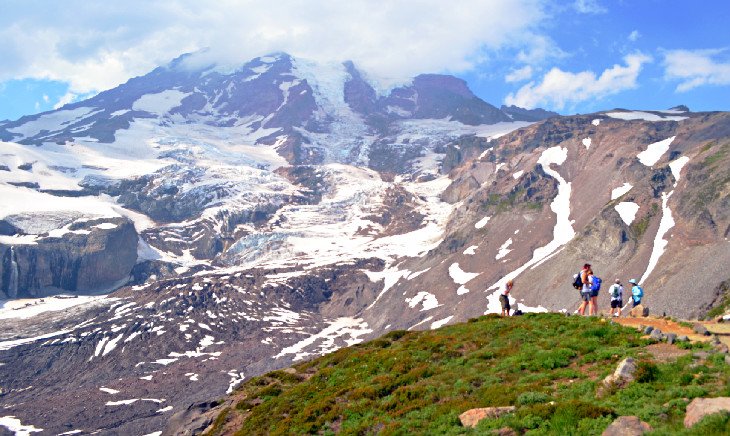
- Within the Park: Of the four auto-campgrounds within Rainier National Park, Cougar Rock and Ohanapecosh Campground are the only two available for advance reservation. Reservations can be made online at Recreation.gov. White River and Mowich Lake campsites are only available on a first-come, first-served basis. Two passenger vehicles are permitted at each individual site at any campground within the park.
- Outside the Park: Many campgrounds dot the national forests of Washington, and much like the campgrounds closest to Mount Rainier, campsites can be reserved ahead of time through Recreation.gov. Each campground has its own regulations, but they generally allow for one vehicle at the campsite and provide fire rings, picnic tables, and basic facilities.
- Backcountry Camps: A permit is always required to spend the night within the national park backcountry. Permits, especially along the increasingly popular Wonderland Trail, can be competitive to obtain. A random lottery for advance permits takes place each year with an application window between March 15th and March 30th. More information on how to apply can be found on the national park's Wilderness Permit page. If you don't receive a permit through the lottery, thirty percent of all backcountry permits are reserved for walk-in availability.
More Related Articles on PlanetWare.com
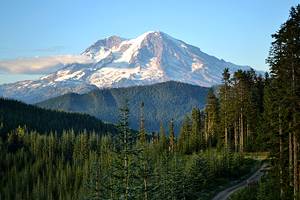
Washington's Parks: For something to do between campground visits at Mount Rainier, it's highly recommended to check out some of the national park's best hiking trails. Mount Rainier isn't the only awesome natural place to check out. See our article on the best state and national parks in Washington to learn about more destinations. Campgrounds and hiking trails in Olympic National Park highlight the unique landscapes of the Olympic Peninsula, found few other places in the country. Near the U.S./Canadian border in Washington, the hiking trails and campgrounds in North Cascades National Park all reveal rugged opportunities for adventure.
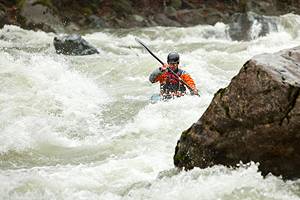
More Outdoor Opportunities: Many of the tourist attractions in Washington State incorporate the lush scenery that defines the region, including plenty of great hiking trails and hot springs. White water enthusiasts will want to check out the best white-water rafting adventures in Washington, and powder hounds might be interested in some of the different ski resorts throughout the state.


